Carl E. Olson's Blog, page 81
September 2, 2014
TIME for some media "nun-sense"!

Sister Maria Francesca Wiley and two other Dominican Sisters of St. Cecilia Congregation in Nashville, Tenn., prepare for Mass July 25 at the Cathedral of the Incarnation, where they made their final profession of religious vows. (CNS photo/Rick Musacchio, Tennessee Register)
TIME for some media "nun-sense"! | Carl E. Olson | CWR blog
"Over the past five years, Roman Catholic communities around the country have experienced a curious phenomenon: more women, most in their 20s and 30s, are trying on that veil. Convents in Nashville, Tenn.; Ann Arbor, Mich.; and New York City all admitted at least 15 entrants over the past year and fielded hundreds of inquiries." — "Today's Nun Has A Veil--And A Blog" (Nov 13, 2006) by Lisa Takeuchi Cullen and Tracy Samantha Schmidt
"Nuns are an endangered species. They are dying and not being replaced." — "The Great Nunquisition: Why the Vatican Is Cracking Down on Sisters" (Aug 31, 2014) by Jo Piazza
The quotes above have something interesting in common: they were both published in TIME magazine. The 2006 article did not try to hide the puzzlement caused by the surge of young, orthodox-minded women entering orders that emphasize the traditional features of the religious life: "Over the past five years, Roman Catholic communities around the country have experienced a curious phenomenon: more women, most in their 20s and 30s, are trying on that veil."
The article published yesterday, however, doesn't have time for young, orthodox-minded sisters: "Today’s nuns are simply too progressive for the Vatican. The Vatican chooses not to celebrate nuns and it chooses not to empower them." The author recounts talking to a young woman who had been "discerning to be a Catholic sister, but changed her mind before she took perpetual vows of poverty, chastity and obedience."
I asked her why and the answer was very simple and yet disheartening.
“I want to work for an employer that values what I do.”
She plans to work for an NGO. She wanted to be of service to the world, but she also wanted to feel empowered in her job.
The young lady might want to use some of that dubious empowerment to pull up Pope Francis' remark that the Church needs to be a Mother, not a “well-organized NGO with a bunch of pastoral plans..." Not that the author has much use for Francis: "Pope Francis has been hailed as a progressive icon. Yet on the subject of women in the Church, he remains loyal to a long-held and antiquated stance: he doesn’t think women should become priests." (Shocking: the pope is Catholic and holds true to Catholic teaching. Go figure. The faith that secular media outlets place in their ability to change and correct the mind of popes is truly tremendous—and frighteningly absurd.)
Ah, antiquated. Without any sense of the ironic juxtiposition, the TIME piece then states: "Nuns are dying out because their population is aging and young women are not joining their ranks in the numbers they once did." Funny how the Faith continues but people die. That's something to ponder, isn't it? Perhaps the author should have spent more time trying to connect the dots rather than score cheap and superficial political points.
In a May 2011 CWR piece, Ann Carey, author of Sisters in Crisis: Revisited—From Unraveling to Reform and Renewal (Ignatius Press, 2013), wrote:
September 1, 2014
The Labor Movement, Teachers Unions, and Catholic Social Teaching

(Images: © ComZeal - Fotolia.com; © Adrian Hillman - Fotolia.com)
The Labor Movement, Teachers Unions, and Catholic Social Teaching | Rev. George E. Schultze, SJ | CWR
Labor Day is an opportunity to reflect on nature of work and the proper role of unions in the light of Catholic social teaching
Catholic religious leaders have long supported the labor movement in the United States because it has promoted the economic wellbeing of workers and their families. The Irish, Italian, and Slavic immigrants of the past, and the Latino immigrants of the present, have gained from the efforts of countless Catholic and non-Catholic labor leaders and supporters who have organized workers for better wages, benefits, and working conditions.
A plethora of Catholic men and women have learned to organize workers and engage both the economic powers that be and the wider civil society through labor unions, often climbing to the pinnacles of labor power. Workers and their families recall self-professed Catholics such as Terrence Powderly of the Knights of Labor, Philip Murray and the United Steel Workers, George Meany and John Sweeney, presidents of the AFL-CIO, Cesar Chavez and Dolores Huerta (co-founders of the UFW), and the present day Maria Elena Durazo of the Los Angeles County Federation of Labor. Catholic social teaching in the wake of the industrial revolution contributed reason and faith to organized labor’s activities, even if indirectly, through participation of Catholic union members and the clergy who helped form them.
In recent years, numerous government, academic and media sources have documented the declining numbers of unionized workers in the United States in both relative and absolute numbers; 12% of the workforce is organized and 6% of the union members are public sector workers. While the number of unionists has declined the political strength of labor has grown, especially in its lobbying, political fundraising, and volunteer campaign work. The public sector unions like the Service Employees International Union (SEIU), the National Education Association (NEA), and the American Federation of Teachers (AFT) are at the apex of their political influence. These service and education unions, as well as the building and trades and health care unions, have a distinct advantage over manufacturing unions. Construction, health care, the hospitality industry, and schools remain state-side with little risk of capital flight; furthermore, the young, the ill, and the elderly normally remain close to home. Similarly, the government (the public sector) tends not to set up shop offshore.
While one can laud, for example, the desire and activities of teachers unions that promote students and their families, serve immigrants, and advocate for economic justice, the union leaders and their allies are tragically promoting anti-life and anti-family initiatives as part of their activism. As significant players in public education, they are encouraging cultural perspectives that reject the values of a great number of Americans, including Catholics and other people of good will. This was not always the case in American education and the union movement.
August 31, 2014
The False Christs of Our Age

Detail from "Christ Carrying the Cross" by Hieronymus Bosch (c.1450-1516) [WikiArt.org]
The False Christs of Our Age | Carl E. Olson | CWR
The exchange in today's Gospel between Jesus and Peter is startling and reveals the stark divide between two ways of living.
There is but one true Jesus of Nazareth, the Incarnate Son of God. But there are many false Christs said to be “the real Jesus” or the “authentic Christ.”
These imposters are as varied as they are numerous: there is Jesus the personal guru, the political revolutionary, the amoral mystic, the Greek Stoic, the socialist, and even the Buddhist.
What unites these “other Christs” is that their handlers and creators either deny that their Jesus died on the Cross or insist the Cross had no supernatural meaning and salvific value. There is a simple reason for this: Satan knows that Christ without the Cross is not Christ at all.
St. John Chrysostom, commenting on the passage in Matthew’s Gospel heard in today’s readings, wrote, “Peter had learned that Christ is the Son of God. But he had not learned of the mystery of the cross and the resurrection.” As we heard last Sunday, Peter had grasped, by the grace of God, that Jesus is “the Christ, the Son of the living God.” He correctly named and identified his Master. But he failed to understand how the Messiah would bring about the salvation of mankind.
The exchange between Jesus and Peter is startling, even shocking. It is supposed to be, for it reveals the stark divide between two ways of living. On one side—that of Satan—is the belief that man is able to actually guide and control the Creator. This can be seen in the popular notion that we can harness and direct the power of God if only we use the right techniques or achieve some sort of elite spiritual enlightenment. Practitioners of this come in many forms, ranging from New Age salesmen to televangelist con men.
On the other side—that of the Savior—is the belief that man is sinful and fallen, desperately in need of healing and redemption. Salvation comes from God, and we receive it through humility and death. “Whoever wishes to come after me must deny himself, take up his cross, and follow me,” Jesus states emphatically, “For whoever wishes to save his life will lose it…”
Just a few verses earlier Jesus had given Simon the name of Peter, or “Rock.” But the Rock suddenly panicked and crumbled when he heard Jesus speaking of suffering and dying. Erasmo Leiva-Merikakis, in his commentary on Matthew’s Gospel, refers wryly to Peter as “Satanic rock.” When Peter opposed God’s plan of salvation, “Jesus gives Peter still another new name: he calls him a satanic skandalon,” that is, an obstacle and a scandal. When Peter lives by faith, he is a solid rock; when he lives according to his own wisdom, he is a stumbling block.
Years later Peter wrote, in his first epistle, of being a “living stone,” and surely he must have been thinking in part of the Lord’s rebuke. He compared those who live by faith with those who “stumble by disobeying the word” (1 Pet 2:7-8). He further warned that the devil, the father of disobedience, “is prowling around like a roaring lion looking for someone to devour” (1 Pet 5:8). It is by self-denial, acceptance of the Cross, and following closely in the footsteps of Christ that we are kept safe from the devil. Our self-made wisdom cannot save or protect us.
The same contrast between man’s flawed thinking and God’s perfect knowledge is addressed by Paul in today’s epistle. In the opening chapter of his letter to the Romans (1:18-32), he described pagan worship as irrational, idolatrous, immoral, and self-aggrandizing. But Christian worship is rational—that is, in keeping with Divine wisdom—holy, and focused on the true God. It consists of being transformed by God so we can know “what is good and pleasing and perfect.”
The false Christs of our age are just that: of this age. They have nothing to do with the Cross because Satan hates that bloody sign and instrument of his destruction. But for those who embrace and carry it, the Cross is life.
(This "Opening the Word" column originally appeared in the August 31, 2008 edition of Our Sunday Visitor newspaper.)
August 29, 2014
“Go and Call Your Husband”: What Enables a Marriage to Endure?
“Go and Call Your Husband”: What Enables a Marriage to Endure? | Dr. Peter Kahn | HPR
The unity of will between a husband and wife that God establishes is realized also through a life that is fully shared. A marriage is contracted as a result of the consent of the spouses, and this consent needs to be renewed each day.
“Go and call your husband,” said Jesus to her, “and come back here.” The woman answered, “I have no husband.” Jesus said to her, “You are right to say, ‘I have no husband’; for although you have had five, the one you now have is not your husband. You spoke the truth there.” (Jn 4: 16-18)
What is real in life? What is true? The Greek word for truth that St. John places on Jesus’ lips here, alethes, literally means “not hidden.” This is the truth to which an eyewitness attests. Jesus indicates that the reality of the situation was that this Samaritan woman was now living with someone who was not her husband.
Divorce and remarriage have certainly been in the spotlight with the upcoming Synod of Bishops in Rome later this year. The words of Jesus in Matthew 19 have received most of the attention:
Some Pharisees approached him, and to put him to the test they said, “Is it against the Law for a man to divorce his wife on any pretext whatever?” He answered, “Have you not read that the Creator from the beginning ‘made them male and female,’ and that he said: ‘This is why a man leaves his father and mother and becomes attached to his wife, and the two become one flesh?’ They are no longer two, therefore, but one flesh. So then, what God has united, human beings must not divide.”
The text indicates that God is the one who joins a husband and wife together. Perhaps, though, by invoking the action of God, the Church just adds respectability to an essentially human institution. If a marriage is primarily something that we ourselves determine and contract, then it will seem quite reasonable to divorce and remarry. It can be unbearable to live with someone who continually antagonizes or dominates you, and it is surely unreasonable to expect the estranged parties to see out their years in loneliness.
If we are to offer a merciful response to the heartbreak that hits such a large proportion of marriages, then we need insight into the ways that God acts.
August 28, 2014
Think the music at your parish could use some improvement?
Want to be able to sing along to the hymns at Mass?

The Ignatius Pew Missal, assembled with the input of many pastors and parish priests from around the country, is an annual subscription-based
worship aid intended for Roman Catholic parishes.
Its purpose is simple: to provide worshipers with a liturgical resource that is consistent with the directives of the Church and accessible to the average parishioner, especially in regards to music.
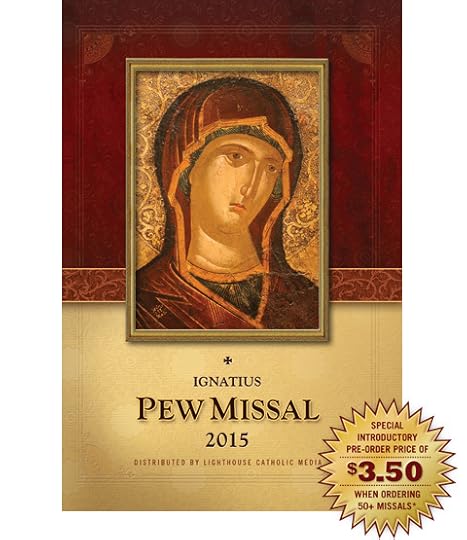
Pre-Order Now
* pre-order offer for those who subscribe in the first year.





Think your pastor might need some convincing?
Pre-order him a personal copy today and save 20%*
with the code PEWMISSAL* at checkout!
Pastor Copy
*This offer is valid online only from August 27, 2014 until September 03, 2014 midnight EST.



Website


YouTube
Copyright © 2014 Ignatius Press, All rights reserved.

Share

Tweet

Forward
The Scriptural Roots of St. Augustine's Spirituality

The Scriptural Roots of St. Augustine's Spirituality | Stephen N. Filippo | IgnatiusInsight.com
Perhaps of all the Church Fathers, none shone so brightly as St. Augustine (351-430). Augustine's spirituality has deeply pervaded the Church right up to this very day. Two great Orders in the Church (just to cite a few), the Benedictines and the Franciscans took their spirituality directly from St. Augustine. St. Augustine's spirituality came into the Benedictine Order primarily through St. Anselm (1033-1109) and into the Franciscans primarily through St. Bonaventure (1221-1274). Both these men were in themselves, also great lights in the Church.
Of course, no discussion of Church giants can be complete without mentioning St. Thomas Aquinas, who is best described as 'following St. Augustine in Theology and Aristotle in Philosophy.' In sum, the Church gets her Dogmatic Theology primarily through St. Augustine. Since Spiritual Theology is based upon the correct Dogmatic Theology, it only makes sense that one of the Church's greatest Theologians, St. Augustine, is also responsible for a great deal of her Spiritual Theology.
And for St. Augustine, as it should be for all Catholics, this means a deep concentration and constant reflection on Sacred Scripture. The scriptural roots of St. Augustine's spirituality can be clearly seen by examining one of his greatest, yet lesser known works, De doctrina Christiana, literally "On Christian Doctrine," but actually "On how to read and interpret Sacred Scripture."
In De doctrina Christiana (henceforth "DDC"), St. Augustine lays the groundwork for a good, spiritual exegesis by elucidating on the virtue of charity, and all that means. Then, in order to begin the climb to spiritual perfection, he explains a scripturally based seven-step ladder. Lastly, he gives seven rules that are helpful in reading and understanding Sacred Scripture correctly.
Charity Towards God, Neighbor And Self
St. Augustine teaches that there are four possible objects of human love: 1. The things above us, 2. Ourselves, 3. Things equal to us, and 4. Things below us. Since all men by nature love themselves, there was no need to give the human race precepts about self-love. And, since it is obvious to most men that they should not love that which is below them, namely lesser objects, but merely use them, fewer precepts are given in the Bible concerning these. But about the love of things above us, namely God and His Angels, and things equal to us, namely other men, Sacred Scripture has everything to say. Our Lord Himself tells us the two greatest commandments are: "You shall love the Lord your God, with all your heart, with all your soul and with all your mind. This is the first and greatest commandment. The second is like it: You shall love your neighbor as yourself. Upon these the whole law and the prophets depend" (Mt. 22: 37-40).
Then, Augustine makes the distinction between enjoyment and use: "Some things are to be enjoyed, others to be used, and there are others which are to be used and enjoyed. Those things which are to be enjoyed make us blessed. Those things which are to be used help and, as it were, sustain us as we move toward blessedness in order that we may gain and cling to those things which make us blessed . . . To enjoy something is to cling to it with love, for its own sake. To use something, however, is to employ it in obtaining that which you love, provided it is worthy of love." (DDC I, iii, 3. iv, 4.) And, for St. Augustine, as it should be for us, the only thing worthy of his love, the only "thing" to be "enjoyed for its own sake" is the Holy, Blessed Trinity, the One True God.
Concerning love of our neighbors, St. Augustine reminds us that "all other men are to be loved equally; but since you cannot be of assistance to everyone, those are especially to be cared for who are most closely bound to you by place, time or opportunity, as if by chance. Just as if you had an abundance of something special that you could only give enough of to one other person, yet two came asking, neither of whom deserved it more or less. You could do no more than choose by lot. Thus, among all men, not all of whom you can care for, you must consider those in your life as if chosen by lot, who, in reality, are chosen by God." (DDC I, xxviii, 29). Therefore, the second great pre-requisite of St. Augustine's for interpreting Sacred Scripture is charity to every person in your life.
Concerning love of self, St. Augustine recommends frequent confession. Our souls in this life are engaged in deadly warfare with the devil and his fallen angels, as well as our own selfishness. As a result, we are constantly being wounded, either in a minor way or mortally. A mortal wound (sin) is deadly and will destroy all opportunity for Eternal Life, if not remedied. If we truly love ourselves, then we will want to be always ready to meet our Maker. The only way to meet our Maker when we die is to be in the state of grace. The only way to maintain the state of grace in this life is to go to confession frequently. We should pay special attention to our worst flaws and beg Our Lord to root them out.
Therefore: 1. set your sights on God alone as the only object of your love and enjoyment, while enjoying other men only for the sake of Him; 2. be truly charitable to all who cross your path, for it is not by accident or random chance that they come into your life; and 3. go to the Divine Physician for the cure to your wounds (sins). Thus are laid down the three most important pre-requisites for correctly reading Sacred Scripture: charity towards God, neighbor and self; without which none can be faithful to the Truths taught in the Bible.
In essence, St. Augustine notes there are those things we are to love for their sake alone, namely the Holy Trinity; and those things we are to love as ourselves, namely all other men. So, whoever in his own opinion feels he understands Sacred Scripture, or any part of it, yet does not build knowledge of love of God and neighbor, "has not yet known as he ought to know." (1 Cor. 8:2) Or, if such a one has discerned from the Scriptures an idea helpful in building this two-fold love, but which was not the intention of the Sacred Author, he is not in error, for his intention is not to lie, but to build up the kingdom of heaven. So, if one is mistaken in his interpretation of Scripture, yet he builds up charity, which is the end of the precept (cf. 1 Tim. 1:5), he is mistaken like the traveler who makes a wrong turn yet ends up at the right place regardless.
However, it is better not to leave the correct path, lest by habitually deviating, one end up in the wrong place altogether. By rashly asserting things the Sacred Author did not intend, one frequently runs into other passages he cannot reconcile to his interpretation. If one in humility gives way to Scripture, fine. But if one loves his own opinion more, he will grow vexed with the Scriptures, and ultimately be destroyed by it. For, "faith will totter, if the Authority of Sacred Scripture waivers. Indeed, even charity itself grows weak, if faith totters. If anyone falls from faith, it is inevitable that he also fall from charity. For he cannot love what he does not believe exists. Yet, if he both believes and loves, by leading a good life and obeying the commandments, he gives himself reason to hope that he may arrive at that which he loves. And so "there abides faith, hope and charity, these three," (2 Cor. 13:1) which all knowledge and prophecy serve" (DDC I, xxxxi, 37.).
Therefore, St. Paul tells us that the greatest of the three theological virtues is charity, because once we have attained to Eternal life, faith and hope cease. They are no longer necessary. Charity alone remains. Therefore it is the greatest of the theological virtues.
St. Augustine notes that, in this life, St. Paul defines charity as having three essential elements: "The end of the precept is charity from a pure heart, and a good conscience and faith unfeigned." (1 Tim. 1:5) Anyone approaching Scripture from truly "charitable" motives and intentions, needs to have a "pure heart," so that one does not love other "things" but only the Holy Trinity. They also need a "good conscience" lest a bad conscience lead to anxiety, guilt and despair, and so alter one's mental state that they seriously misconstrue the Sacred Texts. Thirdly, they need "faith unfeigned" in order to see clearly that which is being asserted by the Sacred Author, and not be blinded or confused by falsehood or affection for "lesser gods." And so by living and believing rightly, we may justly hope that our understanding of Sacred Scripture may build on what is already correct and be deepened and nourished.
St. Augustine's Spiritual Ladder: Seven Steps Mounting To Eternal Wisdom
There are conventional signs which living creatures give each other by which they attempt to indicate, as far as is possible, what is on their mind. For men, some signs involve the sense of sight; many the sense of hearing, and few of any other senses. A nod gives a sign of assent to a person we wish to share our will with. A referee at a football game will raise both hands straight in the air over his head to signify a score. These signs are like visible words. However, among men words have gained a pre-eminence for expressing thought. Holy Scripture, God's Will for us, is communicated to us through words. It is God's Word, in man's words. Jesus Himself is the Eternal Word: "In the beginning was the Word" (Jn. 1:1).
The question then becomes, how do we approach Holy Scripture? First, St. Augustine tells us, is through fear: "Fear of the Lord is the beginning of knowledge, wisdom and instruction, which only fools despise" (Prov. 1:7). It is from fearing God that we first learn to recognize His Will: what He wants us to do and what He wants us to avoid. This fear should awaken in us a healthy reflection of our bodily death and possible spiritual death, if we continue to choose to run away from Him.
Second, fear is tempered by piety, by which we become gentle and humble. So, when Sacred Scripture attacks some of our faults, or when we think we know better than God's Word, we need to reflect and realize that what is written there is more beneficial and reasonable, even if hidden, than what we could know ourselves. Pride is the enemy here. Since the mind usually disdains anything it learns easily, those who read superficially and very quickly, err greatly. Great care and time must put into reading the Sacred Texts very carefully and slowly. A slow, reflective, deeply meditative approach will enhance the ability of the Scriptures to penetrate to your heart.
The third step is knowledge, learning to love God for His own sake and love your neighbor as yourself, for His sake (as previously discussed). Any careful, thorough, close reading of Scripture should clearly point out just how far we have become enmeshed in the love of the world and temporal things. Therefore, it should instill in us a healthy desire to go to confession to get back to loving God and neighbor, whom we separated from when we sinned. Scripture should cause us to mourn our sins. We should beg God through "unceasing prayer" (1 Thess. 5:17) for the consolation of His Divine Assistance.
This brings us to step four: fortitude: to maintain courage, no matter what the cost, in our efforts to obtain True Justice--which is giving God and our fellow men their due, not about getting what I want. In seeking after justice with unwavering perseverance we withdraw from the deadly pleasure of passing things, toward the love of the Eternal Things, namely the Holy Trinity.
The fifth step is the counsel of mercy. As we cleanse our soul, we can become upset and vexed at its constant craving for lesser things. Sometimes it seems that the harder we try to be good, the more evil we do. St. Augustine counsels mercy and kindness in the treatment of your own soul. No one would walk into a hospital and force a sick person to get completely better 'or else'. Then neither should we force this straightjacket method on our sickly soul either. Just like the sick person in the hospital, your soul also needs time to heal. So, be fair with yourself. Set realistic goals. Sometimes baby steps or even crawling are needed before one can walk fully erect again. Seek steady progress, not immediate, absolute perfection, lest you give up in despair. Also, constantly practicing the true, immediate and vigorous unfeigned love of neighbor, to the point of perfection, when you can say you truly "love your enemies"(Mt. 6:12), will help substantially in rooting out one's worst and most stubborn sins.






The sixth step is one of vision: when we can truly see that the more we cleanse ourselves of the love of inferior things in this world, the closer we come to seeing God, "Taste and see how good is the Lord" (Ps. 34:9). To the extent that we love the world, we do not see God. To the degree that we die to ourselves, we experience Him more concretely in our daily lives.
The seventh step is wisdom. While we still walk more by "faith" than by "sight," at this level God so cleanses the heart that we rarely compare our neighbors or other creatures to Him by choosing these 'lesser gods' over Him. Moreover, souls will be so holy and on fire with love of God at this stage, that they will seldom prefer to turn away from the Eternal Truth, through a desire for pleasing men or self-gratification, no matter what. "Everyone who acknowledges me before others, I will acknowledge before my heavenly Father. But whoever denies me before others, I will deny before my heavenly Father" (Mt. 10:32-33).
As the result of following these seven steps, we should grow more deeply in our love and devotion to Our Lord. Moreover, these steps are not mutually exclusive. In other words, one step does not necessarily take place, while the others remain silent. Many times in one's spiritual journey there is an overlapping of stages. What is important here is that we recognize what we are going through, and work with the Sacred Scriptures and these seven steps to allow our hearts to be opened more deeply and thereby move closer to God.
St. Augustine's Seven Rules to Help Unlock the Hidden Mysteries of Sacred Scripture
There was a man named Tyconius, who lived during the times of St. Augustine. He wrote a small book called "On rules" which contained seven rules that he claimed were like keys: they would unlock all that lay hidden in the Sacred Scriptures. Since the man was a Donatist (one who erroneously thought that the validity of a sacrament depended upon the worthiness of the minister), the rules needed some modification. Moreover, as St. Augustine strongly notes, no set of rules, no matter how well put together could ever unlock "all" of Sacred Scripture. Finite man, by definition, cannot possibly begin to completely understand infinite God. Deus semper major--God is always more. So, St. Augustine takes the seven rules because they are very helpful and incorporates them to reflect authentic Catholic teaching.
The first rule is 'about the Lord and His Body.' This rule applies when the Scriptures are talking about Christ and His Church. Sometimes there is a change from head to body and/or body to head, without a change in subject or speaker. For instance, Isaiah 61:10: "Like a bridegroom adorned with a diadem, like a bride bedecked with her jewels," is the same, single person speaking. Of course, one metaphor, the "bridegroom" refers to the Head of the Church, that is Christ, while the other metaphor, the "bride," refers to His Body, that is, His Church.
The second rule is about good and evil. There are passages in Scripture where it appears as if the Sacred Author is ascribing the quality of good and evil to the same person or thing. For instance, the Canticle of Canticles 1:4, says "I am black but beautiful as the tents of Cedar, and I am beautiful as the curtain of Solomon." The "tents of Cedar" are a reference to Ismael, who will not be heir to the Kingdom, "with the son of a free woman." (Gn 21:10; Gal. 4:30) Yet the "curtain of Solomon" can be seen as referring to a King of the line of David (which Our Lord was) or the actual curtain in the sanctuary in the Temple Solomon built. Either way, Scripture appears to be calling the same person both good and evil at the same time. This can be very confusing unless we see that the intention in part is to describe the temporal human condition here on earth. We all have good mixed with bad. G.K. Chesterton once described a saint as "one who knows they are a sinner." So do all groups. No one nation is all good, while the other is all evil. No one occupation has all good people, while another has only bad. Even prostitutes have been known to become great saints: i.e. St. Mary Magdalen, among countless others.
In another instance, in Isaiah 42:16, God says, "I will lead the blind on their journey; by paths unknown I will guide them. I will turn darkness into light before them, and make crooked ways straight. These things I will do for them, and I will not forsake them." Then God immediately addresses the evil person(s), without a grammatical shift, or acknowledgement of a new subject: "They shall be turned back in utter shame . . ." (Is. 42:17). But since for a time we are all here together, "they" is spoken of as if it is one body God is addressing. However, when each person's last day arrives, "He will separate them one from another, as a shepherd separates the sheep from the goats""(Mt. 26:32).
The third rule is concerning one's understanding of Grace and how it works. St. Augustine calls it "the Spirit and the letter." Without going into a detailed analysis of the Theology of Grace, it is important to remember that "without God you can do nothing." In other words, even the ability to have faith and do good works would not be in you unless God first put it there, either through Baptism or Penance. Nor could one continue on doing good works, unless God gave him the grace and the person responded positively. In other words, once Grace is given, it is up to the individual to accept it or reject it, of his own free will. However, he cannot accept it unless he is predisposed to accept it, which is a gift freely given by God.
The fourth rule is "of species and genus," or, how to distinguish between the part and the whole in regard to people, places and things. Scripture can say the word Jerusalem and refer only to that city, the "species." In other places it may refer to Jerusalem (and/or several other cities) but really meaning the entire world, the "genus." This can happen in reference to men too, so that things said about David or St. Peter might exceed the bounds of a special application to them. For instance, when Our Lord tells Peter, "You are Peter and upon this rock I will build my Church, etc." (Mt. 13:16). He not only addresses Peter in that moment, but what He says to him: "Whatsoever you declare loosed upon earth, is loosed in heaven; and whatsoever you declare bound on earth is bound in heaven" also applies to all future Popes.
The fifth rule is "of times," with which intervals of time hidden in the Scriptures may frequently be discovered. This idea of understanding the part for the whole or the whole for the part with regard to time is crucial in determining the amount of days Our Lord spent "in the heart of the earth" (Mt. 12:40). This method of speaking, by which the whole is signified by the part, solves a question about the Resurrection of Christ. For, unless the evening before He died, Holy Thursday; the night He suffered, is also counted, even though it is not a full day, there is no way to arrive at the three days Our Lord prophesied about: "Just as Jonah was in the belly of the whale three days and three nights, so will the Son of Man be in the heart of the earth three days and three nights" (Mt. 12:40).
The sixth rule is called "recapitulation." Some things are so described as though they follow each other in the order of time, or as if they narrate a continuous sequence of events, when suddenly the narrative jumps to previous events which heretofore had been omitted. For instance, we read in Genesis 2:8-9: "And there Lord God had planted a paradise of pleasure from the beginning: wherein he placed man whom he had formed. And the Lord God brought forth of the ground all manner of trees fair to behold, and pleasant to eat of." The narrative seems to be suggesting that God brought forth "all manner of trees" after God had placed man in Paradise. When both things had been mentioned briefly, that is, that God planted Paradise and placed man whom he had formed in it, the narrative returns and recapitulates what was passed over originally. The narrator then adds, "the tree of life also in the midst of Paradise: and the tree of knowledge of good and evil" (Gn. 2:9) and the rivers by which Paradise is irrigated and bound by, and all the gold in paradise, all of which is the creation of Paradise. Once the Sacred Author has completed this narrative, he repeats what he already said concerning what actually followed: "And the Lord God took man, and put him into the paradise of pleasure" (Gn. 2:15). In other words, only after these things were done man was placed there. These things were not done after man was placed there, as what was first said may be taken to mean, unless the recapitulation by which it refers to things omitted earlier is understood by the careful reader.
The seventh rule is about the Devil and his body. Just as the first rule referred to Our Lord and His Body, it is also necessary to stay alert to what pertains to the head, the Devil, and what pertains to his body, the minions of fallen angels. Sometimes when Scripture speaks of the Devil, it is referring not to the devil himself, but to his body, the minions of fallen angels. This body is not only made up of those who are obviously "without," (1 Cor. 5:12) but also of those who, although they belong to it, for a time mingle with the Church until each one of them leaves this life, or until the great threshing fan "separates the wheat from the chaff" (cf., Lk. 3:17).
Lastly, St. Augustine constantly reminds us to pray to God for help in understanding Sacred Scripture. For in these books of Holy Scripture we read: "Pray unceasingly," (1 Thess. 5:17) "because the Lord gives wisdom: and out of His mouth comes prudence and understanding" (Prov. 2:6). Praise the Father, the Son and the Holy Spirit, both now and forever; the God who is, who was, and is to come at the end of the ages. Amen.
This article originally appeared in the January/February 2000 issue of Catholic Faith magazine.
Related IgnatiusInsight.com Articles:
• The Source of Certitude | Epilogue to Faith and Certitude | Thomas Dubay, S.M.
• Seeking Deep Conversion | Fr. Thomas Dubay, S.M.
• Benedict and Augustine | Carl E. Olson
Mr. Stephen N. Filippo, MA., SYD., teaches Theology and Philosophy on both the high school and college level.
Prioress of Dominican Sisters in Iraq chronicles ISIS takeover, expresses fears and frustrations

Sister Aman Miriam places her hands in the hands of her Prioress, Sister Maria Hanna (right), as she makes Perpetual Profession of Vows, in this undated photo from the website of the Adrian Dominican Sisters (www.adriandominicans.org)
Prioress of Dominican Sisters in Iraq chronicles ISIS takeover, expresses fears and frustrations | Carl E. Olson
| CWR Blog
Sister Maria Hanna: "The disaster is overwhelming, and we are unable to comprehend it all."
Sister Maria Hanna, Prioress of the Dominican Sisters of St. Catherine of Siena in Iraq, has been posting about the harrowing situation there over the past several weeks. In an August 5th post, she describes the upheavel and exodus taking place in Mosul and Karakosh (Qaraqosh):
So far, 510 families have been displaced from Mosul. Some were fortunate to leave before the deadline ISIS set as they were able to take their belongings with them. However, 160 families of them left Mosul with only their clothes on; everything they had was taken away from them.
These families are in so much need of help and support. People in Christian towns that received these refugees opened their homes to provide shelters and food for them, as much as they could. People are strongly willing to help, but the fact that they did not have their salaries for two months (June- July) makes it extremely difficult for them to offer more. As the salaries of government employees in areas under ISIS control are being suspended. Additionally, because of the present situation in Mosul and the whole province (of Nineveh) the economy of the state is suffering, which naturally affects everyone. Since the tension started in Mosul, many people lost their jobs as 99% of jobs stopped, which means there is hardly any money to be used let alone loaning to those who are in need. This is not only in the province of Nineveh, but also in Erbil. Moreover, all Christians in the plain of Nineveh have not received their food supplement, which the government used to provide via the smart ration card. This is causing a crisis not only for the refugees, but also for the residents in the area. ...
As you perhaps know, concerning the situation in Mosul, the Islamic State has a policy in governing the city. After displacing the Christians, they started their policy concerning the holy places that angered people. So far, the churches are under their control; crosses have been taken off. But we are not sure about the extent of the damaged done in them. In addition to that, few mosques have been affected, too. The ISIS destroyed two mosques with their shrines last week: the mosque of Prophet Sheeth (Seth) and the mosque of the Prophet Younis, or Jonah, said to be the burial place of Jonah. The militants claim that such mosques have become places for apostasy, not prayer. This was really too painful for all people as Jonah’s shrine was considered as a monument. Also, it was a historical place as it was built on an old church. Destroying such places is a destruction of our heritage and legacy.
She then penned this poignant plea: "We are surprised that some countries of the world are silent about what is happening. We hoped that there would be stronger international approach toward Iraq, and Christians in Iraq in general. As for us as community, our sisters in Batnaya and Telkaif had to leave the town with 99% of people who left because of violence outside the town."
Just three days later, Sister Maria wrote again: "You might be surprised that we are writing this letter so soon since you received the last one. But events are happening so quickly here shocking everybody because of its brutality and cruelty." She described the escalation of violence and attacks, and then wrote that the Sisters would have to leave Karakosh, Iraq's largest Christian city:
On the seventh of August we gradually started to understand that the Peshmerga, who were supposed to protect Karakosh, were pulling out, leaving the town unprotected. Everybody was shocked because Kurdish government promised to defend Karakosh, and the other Christian towns. At the same time, ISIS started to get closer to Karakosh and the residents stared to leave the town. As a community, in no time we were to prepare to leave; we took the least with us unaware of what to take and unable to comprehend what was really happening. There were thirty sisters left Karakosh in three cars, and two families accompanied us, as they had no place to go. Three Franciscan sisters came with us, too. When we left the convent, we were surprised to see a big number of people leaving the town on foot. Moreover, it was strange to see only very few guards at the checkpoint when we were leaving the town. We were not alone on this, other towns shared the same horror. Christians from fifteen villages among them Karamles, Bartela, Bashiqa, Telkaif, Baqofa, Batnaya, Telusquf were forced to leave their homes because ISIS was advancing. Our sisters also left their convents in these towns. In Telkaif, while a young man (Lugin) with a young priest were trying to help a lady who was not able to leave on her own, he was shot and killed by the ISIS.
Our exodus started at 11:30 pm, and before that we decided to pray and have the Holy Communion so that if the ISIS entered the house, it will not be defiled. But on the last minute, we decided to leave one piece in the tabernacle praying it will protect the house and the town. ...
We cannot what will happen or until when people will stay like this nor what the ISIS will do to our towns, nor if we will ever be able to get back home. Everything is so unclear. The situation is extremely difficult. For the time being people have some money to support themselves, but no one knows how long they will endure with the little they have.
As for the safety, Erbil is a Kurdish city and most refugees are staying in Ankawa that is a Christian suburb and protected by Peshmerga. It is hard for people to believe that even this city is safe that’s why they are thinking more and more to leave the whole country.
You may ask what the world can do for us. We would say, stop the blood, stop the oppression, and stop violence. We are human beings here; stop making us target for your weapon. The world needs to stand as one to protect minority against the evil and injustice. People want to live normal life in peace and dignity.
In an August 17th post, Sister Maria detailed the desperate situation faced by refugees:
August 27, 2014
Sacred Tradition: The Forgotten Doctrine?
Sacred Tradition: The Forgotten Doctrine | Stephen J. Morrissey | Homiletic & Pastoral Review
The miracle and mystery of divine guidance has been the primary constituent element of Church teaching over the centuries, and this guidance is what makes Tradition “sacred,” but rarely is it linked with the teaching of any other doctrine.
In my preparations for teaching an RCIA class recently, I noticed that, in the manuals and catechisms which I perused, there was sparse attention paid to what is the most foundational Catholic doctrine of all—Sacred Tradition. Its explanation is typically relegated to a page, if not a paragraph, in these texts, may be scattered here and there (in one case near the end of the book), and treated as just another doctrine to be held by Catholics. Usually there is an explanation of the “basics”: the etymological Latin derivation of the word “tradition,” reference to apostolic succession and the apostolic deposit, the action of the Holy Spirit in guiding the transmission of faith, and Tradition’s role in a complementary pairing with Scripture to form Revelation.
The miracle and mystery of divine guidance has been the primary constituent element of Church teaching over the centuries, and this guidance is what makes Tradition “sacred,” but rarely is it linked with the teaching of any other doctrine. Yet, it is the sine qua non of all doctrines, the font, the key, the source—and if Catholics don’t understand and remember it as the basis for all other Church teaching on faith and morals, then they cannot logically understand and accept other doctrines. Perhaps, this partially explains why we have so many “cafeteria” Catholics, and so many Catholics in open dissent from Church teaching. If the Holy Spirit is not guiding the Church in all of its teaching on faith and morals, then it may not be guiding the Church in any of its teachings. If the deposit of faith handed on through the centuries is only a nice idea when convenient, and not a constant reality, then Catholic faith is meaningless. But if the Holy Spirit is, indeed, guiding and animating the Church, then the subject of Sacred Tradition should be front and center in every one of our faith presentations, and linked directly to other doctrines as the ultimate certitude of that doctrine’s truth. The doctrine of the Immaculate Conception, for example, is credible only if referenced to Sacred Tradition. Presently, from my examination of a representative sample of Catholic catechetical texts, I would say that the importance of Tradition is, in fact, understated in the hundreds of pages of various books, and lost in the catechesis of the myriad of other Catholic teachings. For many Catholics and prospective Catholics, then, the importance of this essential doctrine may fade away, and, for all practical purposes, be forgotten. The insufficiency of catechetical attention to Tradition was recognized by Pope John Paul II in his General Directory for Catechesis in 1997: “It is necessary, however, to examine with particular attention some problems so as to identify their solutions—with regard to the fundamental direction of catechesis, catechetical activity is still usually impregnated with the idea of Revelation, however, the conciliar concept of Tradition is much less influential as inspiration for catechesis. In much catechesis, indeed, reference to Sacred Scripture is virtually exclusive, and unaccompanied by sufficient reference to the Church’s long experience and reflection, acquired in the course of her two-thousand-year history. The ecclesial nature of catechesis, in this case, appears less clearly; the interrelation of Sacred Scripture, Tradition, and the Magisterium, each according to “its proper mode,” does not yet harmoniously enrich a catechetical transmission of the faith. 1
Sacred Tradition is important because it is the first, or source, doctrine insofar as we can say that it “began” on Pentecost when the Holy Spirit descended upon the Apostles, and they began preaching from the deposit of faith. The Church, from its first days, claimed guidance by the Holy Spirit, as promised by Christ, who would teach it everything, and be with it for all time.
Tradition is also important because it is all encompassing.
Classical Education, Freedom, and the Ordered Soul

Detail from "The School of Athens" (1510-1511) by Raphael (www.wikiart.org)
Classical Education, Freedom, and the Ordered Soul | Fr. James V. Schall, S.J. | CWR
Understanding is a spiritual thing, though rooted in really existing things, even ultimately in divine things
Editor's note: This essay was originally given in a slightly different form as an address, “On Not 'Keeping Quiet About a Study'”, at Kolbe Academy & Trinity Prep, in Napa, California, on August 8, 2014.
“Athenian: ‘We generally say that so far as the supreme deity and the universe are concerned, we ought not to bother our heads hunting up explanations, because that is an act of impiety. In fact, precisely the opposite seems to be true.’
“Clinias: ‘What’s your point?’
“Athenian: ‘My words will surprise you, and you may well think them out of place on the lips of an old man. But it’s quite impossible to keep quiet about a study, if one believes it is noble and true, a blessing to society, and pleasing in the sight of God.”
— Plato, The Laws, #821a.
I.
A recent essay in the New Republic was entitled “Don’t Send Your Kids to Ivy League Schools” (July 21, 2014). Its thesis was that such schools merely prepare snobs who belong to a wealthy elite mostly out of touch with real people. We can be almost certain that this admonition not to send our kids to Ivy League schools will increase the number of their applicants. Snobs like to be with snobs. An elite likes to meet other elite.
The solution to this presumed problem, offered by the author, himself an Ivy League grad, was to send most everyone to state schools at state expense. This solution would assure equality and more diversity. I call this proposal “the totalitarian solution to the elitist problem.” It is the natural offspring of never having read with care Plato or Aristotle.
Allan Bloom, in his Closing of the American Mind, had already said that the unhappiest people in our society today are those students who go to the twenty most expensive universities. He also said, as if this fact might just be the source of the problem, that any professor, on entering a classroom, can assume that every student is, or thinks he is, a relativist. That is, he is someone who does not think that any truth is possible. Pope Benedict often spoke of the same issue at the cultural level.
The current annual tuition at Loyola/Marymount in Los Angeles, someone told me recently, is $53.000. The tuition per semester at Santa Clara when I was a student there in the 1940’s was $250. Loyola seems to have no difficulty in attracting students. Whether that is enough to make it an elite school is doubtful. Really elite universities generally waive tuition costs for students who cannot afford it if they can qualify to pass entrance requirements. An “elite” school today is one that can give free rides to the students it desires, such as football players. Just where the best education is given is not easily answered in terms of prestige, money, or state power. In fact, as I have often observed, the best education may well be mostly outside any academic institution.
Pope Francis often speaks of jobs and unemployment. He cites the number of unemployed youth in Europe, some 75 million. He talks about the frustration of youth who have no employment future even with education; he thinks a job is almost basic to human dignity. On the other hand, many economists tell us that there is no need for so many jobs in the future. Technology is rapidly replacing most all jobs but the menial ones. And immigrants are taking these latter jobs. There is some employment but we have to be highly educated in technology. We saw animals replaced by machines. Now we see that machines replace stores, robots replace factory workers, money is replaced by cards and automatic tellers, stores and shops are replaced by Costco, and Costco is replaced by Amazon.com. Newspapers and journals are on-line. Books are on Kindle,.
Writers like Wendell Berry think that this process is a disaster for the culture. The culture of family tradition, work, and social cohesion is broken when the young begin to go off to college. They seldom return to their places of origin. This view is the American take on the developmental brain drain in which the educated class left their countries for education and never returned. There is a small back-to-the-land, distributist movement. But this appears to be more like a hobby, however healthy it may be for the few who can still live on the land. E.F. Schumacher’s Small Is Beautiful was also an attempt to gear machinery to a human size and not to make man a stranger among monstrous machines. Technology responded by making the tiny machines everyone carries in his pockets so they can talk to anyone, any time, any place in the world.
Looked at from another angle, however, the world has made great strides in reducing and eliminating poverty.
August 26, 2014
New books and key experts available in time for October Synod on Marriage and Family
Ignatius Press delivers one stop for resources into hotly debated topics at Vatican meeting
SAN FRANCISCO, August 26, 2014 – Communion for divorced and civilly remarried Catholics, the indissolubility of marriage, cohabitation and contraception are just a few of the many controversial topics to be discussed when Catholic bishops from across the globe meet with Pope Francis at the Extraordinary Synod of Bishops Oct. 5-19 at the Vatican.
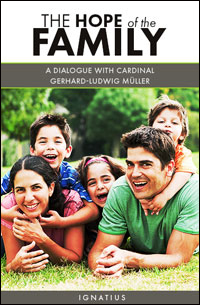
Ignatius Press, one of the largest religious publishers in the world, is publishing four books in the fall that will address issues of the upcoming synod. The Catholic publisher will also have a number of authors available to comment on the topics before and during the Synod.
THE HOPE OF THE FAMILY: A Dialogue With Cardinal Gerhard Muller, written by Gerhardt Ludwig Muller, addresses some of the main problems with the family in the Church today — the large number of Catholics who live together before marriage, who marry civilly, or who do not even bother with marriage, as if these choices were sound options for Catholic living.
In this engaging conversation, Cardinal Müller, one of Pope Francis' top advisers in the Vatican, discusses the challenges facing marriage and family life today. The loss of faith in many traditionally Christian societies has led to a crisis. In turn, cohabitation, civil marriage, and divorce and civil remarriage, further undermine faith because they harm the family as the “domestic Church” and the place of initial evangelization. The solution, according to Cardinal Muller, is that the Church must undertake a robust new evangelization of the family — sharing the fullness of truth about marriage and family in Christ, encouraging families to worship and pray together, and helping them witness by their lives to the joy of the gospel.
Cardinal Müller stresses mercy and compassion in pastoral ministry with struggling Catholics, without contradicting the teaching of Jesus about divorce and remarriage and minimizing the power of grace to transform lives. He proclaims hope for the family rooted in the Gospel of Jesus Christ.
THE GOSPEL OF THE FAMILY: Going Beyond Cardinal Kasper’s Proposal in the Debate on Marriage, Re-Marriage and Communion in the Church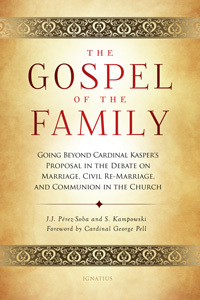 , written by theologians Stephan Kampowski and J.J. Perez-Soba, critiques Cardinal Kasper’s proposal for a different approach to the issue of divorce and civil remarriage in the Catholic Church.
, written by theologians Stephan Kampowski and J.J. Perez-Soba, critiques Cardinal Kasper’s proposal for a different approach to the issue of divorce and civil remarriage in the Catholic Church.
The authors appreciate certain elements of Kasper’s proposal while criticizing some of its doctrinale, pastoral, and pastorals elements. The book is a positive contribution providing an alternative merciful pastoral approach inspired by the Magisterium and by the testimony of Saint John Paul II, whom Pope Francis has held up to the whole Church as “the Pope of the Family.”
REMAINING IN THE TRUTH OF CHRIST: Marriage and Communion in the Catholic Church,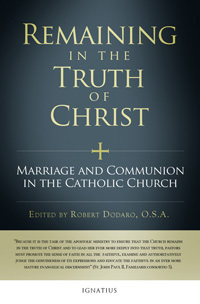 written by Robert Dorado, O.S.A, is an in-depth response by five well-known Cardinals — Walter Brandmüller, Raymond Leo Burke, Carlo Caffarra, Velasio De Paolis, C.S., and Gerhard Ludwig Müller — and four other scholars — Dodaro, Paul Mankowski, S.J., John M. Rist and Archbishop Cyril Vasil, S.J. — to Cardinal Kasper’s proposal regarding marriage, civil re-marriage and reception of the Eucharist.
written by Robert Dorado, O.S.A, is an in-depth response by five well-known Cardinals — Walter Brandmüller, Raymond Leo Burke, Carlo Caffarra, Velasio De Paolis, C.S., and Gerhard Ludwig Müller — and four other scholars — Dodaro, Paul Mankowski, S.J., John M. Rist and Archbishop Cyril Vasil, S.J. — to Cardinal Kasper’s proposal regarding marriage, civil re-marriage and reception of the Eucharist.
The book draws on both biblical texts and early Christian writings on marriage, and shows how the Church’s longstanding fidelity to the truth of marriage is the irrevocable foundation of its mercy in its pastoral practice with civilly remarried, divorced people.
ON HUMAN LIFE: Humane Vitae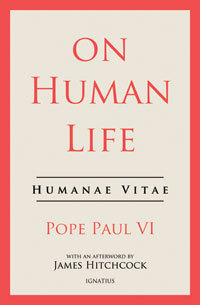 , written by Pope Paul VI and rereleased featuring a new foreword from Mary Eberstadt and a new afterword from James Hitchcock, is Pope Paul VI’s explanation of why the Catholic Church rejects contraception.
, written by Pope Paul VI and rereleased featuring a new foreword from Mary Eberstadt and a new afterword from James Hitchcock, is Pope Paul VI’s explanation of why the Catholic Church rejects contraception.
Paul VI referred to two aspects, or “meanings,” of human sexuality — the unitive and procreative aspects. Paul VI also warned of the consequences if contraception became widely practiced — greater infidelity in marriage, confusion regarding the nature of human sexuality and its role in society, the objectification of women for sexual pleasure, compulsive “family planning” and contraceptive policies by government, and the reduction of the human body as an instrument of human manipulation, all of which have come to pass. Other dangers such as genetic engineering and human cloning are on the horizon.
St. John Paul II’s popular “theology of the body” drew deeply on the insights of Paul VI. Pope Benedict and now Pope Francis have upheld the long-standing teaching. Indeed, a new generation of Catholics is embracing ON HUMAN LIFE: Humane Vitae.
For more information, to request a review copy or to schedule an interview with any of the key experts, please contact Kevin Wandra (404-788-1276 or KWandra@CarmelCommunications.com) of Carmel Communications.
Carl E. Olson's Blog
- Carl E. Olson's profile
- 20 followers





